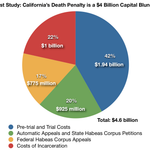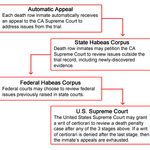

by Judge Arthur L. Alarcon & Paula M. Mitchell
published in 44 Loyola of Los Angeles Law Review S41, Special Issue (2011)
"Since reinstating the death penalty in 1978, California taxpayers have spent roughly $4 billion to fund a dysfunctional death penalty system that has carried out no more than 13 executions."
UPDATE: Judge Alarcon and Prof. Mitchell issued an updated version of their article on the costs of the death penalty in California. Their abstract states:
In a 2011 study, the authors examined the history of California’s death penalty system to inform voters of the reasons for its extraordinary delays. There, they set forth suggestions that could be adopted by the legislature or through the initiative process that would reduce delays in executing death-penalty judgments. The study revealed that, since 1978, California’s current system has cost the state’s taxpayers $4 billion more than a system that has life in prison without the possibility of parole (‘LWOP’) as its most severe penalty. In this article, the authors update voters on the findings presented in their 2011 study. Recent studies reveal that if the current system is maintained, Californians will spend an additional $5 billion to $7 billion over the cost of LWOP to fund the broken system between now and 2050. In that time, roughly 740 more inmates will be added to death row, an additional fourteen executions will be carried out, and more than five hundred death-row inmates will die of old age or other causes before the state executes them. Proposition 34, on the November 2012 ballot, will give voters the opportunity to determine whether they wish to retain the present broken death-penalty system—despite its cost and ineffectiveness—or whether the appropriate punishment for murder with special circumstances should be life in prison without the possibility of parole.
The new article is: Judge Arthur L. Alarcón and Paula M. Mitchell, Costs of Capital Punishment in California: Will Voters Choose Reform this November?, 46 Loy. L.A. L. Rev. S1 (2012). It is available in full text at http://digitalcommons.lmu.edu/llr/vol46/iss0/1.
The authors concluded that the cost of the death penalty in California has been over $4 billion since 1978.

Breakdown of Costs in California’s Death Penalty System
| Pre-trial and Trial Costs | $1.94 billion |
| Automatic Appeals and State Habeas Corpus Petitions | $0.925 billion |
| Federal Habeas Corpus Appeals | $0.775 billion |
| Costs of Incarceration | $1 billion |
| TOTAL | $4.6 billion |
Pre-Trial and Trial Costs: $1.94 billion
1,940 capital trials x $1 million per trial = $1.94 billion
Automatic Appeals and State Habeas Corpus Petitions: $925 million
Estimated $50 million per year average cost 1999-2010 (12 years): $600 million
Estimated $25 million per year average cost 1985-1998 (13 years): $325 million
(Does not include estimated costs for any appeals filed before 1985)
Annual Costs of Automatic Appeals and State Habeas Corpus Petitions
| Agency | Most Recent Capital Appeals Budget |
| California Supreme Court | $15,406,000 |
| Habeas Corpus Resource Center | $13,857,000 |
| Office of the State Public Defender | $12,000,000 |
| Office of the California Attorney General | $17,300,000 |
| Total | $58,563,000 |
Federal Habeas Corpus Appeals: $775 million
350 CJA cases x $635,000 per case = $222,250,000
350 FPD CHU cases x $1.58 million per case = $553,000,000
Costs of Incarceration: $1 billion since 1978
"The current backlog of death penalty cases is so severe that most of the 714 prisoners now on death row will wait well over 20 years before their cases are resolved. Many of these condemned inmates will thus languish on death row for decades, only to die of natural causes while still waiting for their cases to be resolved."
Legislative History of the Death Penalty in California
Since 1978, all of the state’s death penalty legislation has been adopted through the passage of initiatives by a majority of voters. From 1978 to 2000, California voters have raised the number of death-eligible crimes from 12 to 39. The Briggs Initiative in 1978, which was proposed with the intent of creating the nation’s toughest death penalty, more than doubled the number of death-eligible crimes. Two propositions passed in 1990 added 5 death-eligible crimes and caused the death row population to balloon from 279 to 461 in just 4 years. Each time the death penalty was expanded in California, voters were told that the costs of expansion were “unknown” or “minor.”
"Considering that habeas corpus relief has been granted by federal courts in 70% of California's death row inmates' cases, a significant number of inmates who died while their petitions were pending may have had their convictions or death sentences set aside. but for the unconscionable delay in judicial review."
Hazardous Conditions Ahead: Potential state and federal constitutional issues arising out of California’s current death penalty scheme
In analyzing the past death penalty initiatives enacted in California, the authors found several issues that could, if reviewed in state or federal court, lead a court to overturn California’s death penalty. These constitutional questions include:
“Despite the consensus of state and federal officials supporting the call for Congress, the California Legislature, and the Governor to implement the necessary changes to provide for continuity of state and federal capital habeas counsel, no action has been taken to address this complete breakdown in the system. There have been no fewer than 13 bills introduced in the California Legislature since 2005 that have proposed various reforms to the administration of the death penalty in California, including moratoriums, capital trials, appeals, habeas proceedings, or housing of death row inmates. All have either died in committee or failed to pass.”
Remedies Revisited
The authors address and update the recommendations for reform made in Judge Alarcon’s 2007 article, “Remedies for California’s Death Row Deadlock,” published in the Southern California Law Review. These recommendations deal with shortcomings in the death penalty appeals process in California.

Remedies:
1. Automatic Review by the California Court of Appeal
2. State Habeas Petitions filed first in the Trial Courts
3. Increase Funding for Capital Appellate and Habeas Counsel
Reform and Abolition in Other States
“We hope that California voters, informed of what the death penalty actually costs them, will cast their informed votes in favor of a system that makes sense.”
Roadmap for Reform
Because the current system is the result of voter initiatives, any death penalty reforms in California must be implemented through voter initiatives. The authors suggest 5 propositions to reform or abolish capital punishment in California:
Propositions 1 and 2: Reform the Death Penalty but leave its current scope unchanged
1. Direct the legislature to fix the system by providing adequate funding for the appointment of qualified counsel and by creating an agency to ensure continuity of counsel through state and federal habeas appeals.
2. Amend the California Constitution to allow automatic reviews to be undertaken by the California Court of Appeals rather than the CA Supreme Court. The Supreme Court could still have discretionary review in order to correct erroneous rulings or resolve conflicts among various districts
Proposition 3 and 4: Reform the Death Penalty by narrowing the number of death-eligible crimes
3. Reduce the number of death eligible crimes to 5 so that those sentenced to death truly represent the worst of the worst. (39 crimes are currently death-eligible.)
4. Narrow the death penalty to cases in which the prosecution presents scientific or video evidence of guilt, or in which there is a recorded confession. This system is currently in place in Maryland.
Proposition 5: Abolish the death penalty and replace it with a sentence of life without the possibility of parole
5. Assuming that the Governor would commute the sentences of those remaining on death row to life without parole.